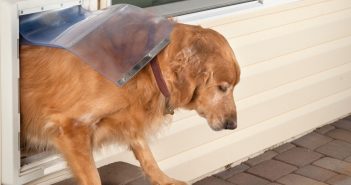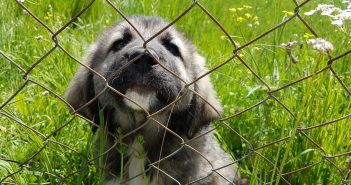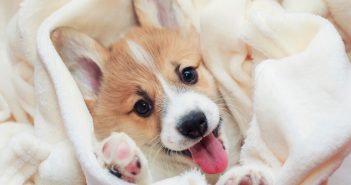“He came out of the night, appearing suddenly in my headlights, a big, golden dog, panting, his front paws tapping the ground in an anxious little dance. Behind him, tall cottonwoods in their April bloom. Behind the grove, the San Juan River, moving quickly, dark and swollen with spring melt.”
Want to read more?
We did, too. Merle’s Door, Lessons from a Free Thinking Dog, had us from “HELLO!” and the author, Ted Kerasote, never let up.

Far from the usual story about a beloved pet, Merle’s Door, at times, reminded me of an rugged outdoors version of Travels With Charley, though Steinbeck’s story centered on his journey around America while Kerasote’s story centered on his inner journey and the connection between man and man’s best friend. It’s not a coincidence that I mention those two authors in the same paragraph. I’ve long been a Steinbeck fan, and I now consider myself a brand new Kerasote fan. The story of Merle is constantly captivating and intensely informative without being the least bit boring and the writing style is actually something to celebrate. Best of all, the story being told is one of mutual respect earned and given, depicted through the eyes of a man who didn’t go looking for it.
Here’s the official description:
Merle and Ted found each other in the Utah desert. Merle was about ten months old, surviving on his own, and looking for someone to hang his heart on. Ted was forty-one, liked to write about animals, and had been searching for a pup whom he could shape into a companion. The training went both ways. Ted showed Merle how to live around wildlife, and Merle reshaped Ted’s ideas about the complexity of a dog’s mind by showing him how a dog’s intelligence could be expanded by allowing it to make more of its own decisions.
Acting as Merle’s translator, and using Merle’s life and lessons as a door into the world of dogs, Ted Kerasote takes us on the journey they shared. He explores why the dog-human bond is so intense and how people and dogs can communicate readily with each other. He also uses the latest wolf research—showing that wolves treat maturing pups as partners rather than as subordinates—to explain how sharing leadership with your dog, rather than being its alpha, can help to create a healthier, more self-reliant, and better-socialized companion.
And here’s a wonderful interview with the author, Ted Kerasote:
Q:Merle’s Door: Lessons from a Freethinking Dog distinguishes itself from the rest of the pack of dog memoirs by offering readers fascinating facts about canine genealogy and the evolution of human-dog interaction. How long did it take you to research the book?
A:One of my aims in writing Merle’s Door was not only to tell the story of a remarkable dog who was one of my best friends, but also to give readers accurate information about the origins of dogs, the dog-human partnership, and how dogs think. My hope is that readers can then apply this information to their relationships with their own dogs. For this information to be both accurate and current, I went to the latest primary sources. Reading scientific papers, interviewing some of the scientists who wrote them, and reading widely in the dog literature took me two years.
Q: Most people subscribe to the commonly held belief that they should dominate their dogs. You suggest a different approach—essentially one that lets dogs be dogs. Why do you think that many owners have a hard time accepting this theory? Do you think they would change the way they treat their dogs if they were aware of this model and the potential it has to improve their relationship with their four-legged friends?
A:This is a complex issue—and one of the major themes of Merle’s Door—so please forgive me if my answer is a bit long. I think that a lot of dog owners have a hard time letting their dogs be dogs—in other words, diminishing their authority over them—because, frankly, authority is addictive. In our western democratic society, dogs offer us one of the very few relationships in which we can exert unlimited authority and even physical punishment with almost no legal or moral constraints. In return, we’re obeyed—not merely obeyed, but also loved, or at least fawned upon. This one-sided relationship is psychologically soothing; it transports us back to our infancy when we can demand anything of our parents, and usually get it. Not many of us—unless we’re CEOs or the rulers of countries—can get away with this sort of behavior as adults except in our relationships with dogs. Sit, stay, lie down, be quiet, see you in eight hours when I come home from work—this kind of authority is heady and hard to relinquish.
Such power is also hard to relinquish because dog trainers constantly advise us to be strong alphas to our dogs. After all, that’s how alpha wolves treat their subordinates—they keep the pack in order and everything running smoothly, right? The problem with this reasoning is that it’s been derived from observing captive wolf packs, and they’re dysfunctional. As eminent wolf biologist David Mech has pointed out, “Such an approach is analogous to trying to draw inferences about human family dynamics by studying humans in refugee camps.”
It wasn’t until researchers began watching wild, unmolested wolf packs at the end of the twentieth century that they discovered that wolf society is a lot more egalitarian than anyone had imagined. The so-called alpha wolves, the breeding adults, actually share leadership with their maturing pups, letting them decide whom to hunt, when to hunt, and where to move the pack. The parent wolves don’t always have to be obeyed by their teenage wolves—meaning there’s free will in wolf society. Yet parent wolves are frequently listened to because, just as in human society, it’s the elders who have wisdom to impart.
Since dogs are wolves—genetically and psychologically—they, too, want some say in conducting their lives as they grow up. They want some authentic freedoms while also listening to those who are their elders, their human partners. Keeping one’s dog a perpetual child and quashing this natural maturation process by not giving the dog some leeway in conducting its own affairs—especially providing it off-leash time in which to socialize with other dogs—often leads to what this heavy-handed approach does in child rearing: the dog acts out or becomes a yes-dog, obeying mindlessly and not realizing its full mental capabilities.
Merle sidestepped many of these pitfalls through some bad fortune. He began life on his own—abused, shot at, and having to catch his own food to survive. But there was a silver lining to these hardships; they made him resourceful, self-reliant, and self-actualized. When we found each other and I gave him his own dog door so he could come and go as he wished, I simply fostered his innate curiosity and ability to solve problems on his own. The result was a dog who was my peer in many ways—who taught me rather than the other way around. I’ve hoped that in writing his biography I might convey the value of loosening the leash, in all aspects of our dogs’ lives, and by so doing mentoring them to become freer thinkers and equal partners.
Q: As Merle ages, you try a variety of holistic methods to alleviate his ailments, including acupuncture, massage, and dietary supplements. Are these types of treatments relatively new in the field of veterinary science? Did you encounter any raised eyebrows when you informed others that Merle was being treated with alternative medicine?
A: Sure! There were many people who said, “You’re giving Merle acupuncture? Gimme a break!” But acupuncture, massage, and dietary supplements helped to make him a fit and healthy dog into his early teens. At thirteen he was still climbing big mountains and skiing off of them—thousands of vertical feet. These days, vets at the cutting edge of their profession endorse such therapies, and I cite them and their work in Merle’s Door.
Q: You’ve had numerous adventures around the globe—climbing mountains and navigating rivers—and your love of nature and the environment is evident in your writings, including Out There: In the Wild in a Wired Age. What is it about the wilderness that appeals to you, as a New York native now living on the outskirts of Grand Teton National Park in Wyoming?
A: “Native” is a curious word; it refers to the spot on Earth where you took your first breath and perhaps grew up. It doesn’t necessarily describe the origins of your native sensibilities and passions. That was the case with me. My earliest childhood memories are of being unhappy in Manhattan, of not feeling comfortable in my skin until my family bought a summer place on Oyster Bay, in what was then rural Long Island. I really became a native there, on the water, fishing, and hunting; but soon that place wasn’t native enough for me.
Even as a twelve-year-old boy I had photos of the Rockies and its wildlife hanging on the walls of my bedroom, and I left for the West as soon as I could. What appealed to me about the West’s wild places, as well as all the wild places I’ve had the good fortune to visit since then, is their purity. There are no malignant intentions in the wilderness, none of the pathology that causes so much human tragedy. Being drowned in a kayak or buried in an avalanche is certainly sad, but neither the sea nor the snow intend to harm a person out of greed, hatred, or misanthropy. Consequently, traveling in such wild places has returned me to innocence, which is really everyone’s first native land.
Q: You and Merle spent a lot of quality time together on hunting expeditions, and you have previously examined both sides of the hunting issue in Bloodties: Nature, Culture, and the Hunt How does hunting for food, not sport, connect you with nature?
A: Hunting for food has provided me with an ever-scarcer relationship in a world of cities, factory farms, and agribusiness—participation in the natural cycles that run the planet as well as having direct responsibility for taking the lives that sustain me. And all of us—whether we’re carnivores, omnivores, or vegans—take animal life to feed ourselves. Some of us, the hunters, do this directly. Some of us, the eaters of domestic meat, have someone else do the killing for us. Even vegans participate, indirectly, in the killing. As I and many other writers have pointed out, farming—even organic farming—takes the lives of animals. They’re killed when crops are harvested; they’re displaced by fencing; and they’re killed on highways as our food is transported from farm to market. Hunting makes me present, mindful, and perpetually thankful for the sacrifices others make so I might live.
Q: If you wrote an obituary in celebration of Merle’s life, what would it say?
A:Well, that’s easy—I’d write Merle’s Door. But if I had to give an abridged version, it would be this one, which is what I sent out to his many friends the day after he died:
Merle
Sometime in the spring of 1990—June 10, 2004Found on the San Juan River in Utah as a pup, came of age in Jackson Hole
Consummate skier, avid peak bagger, tireless elk and antelope hunter, hiker . . .
mountain biker . . . river runner . . . horsepacker . . . dancer
Renowned singer
Occasional ham.Watcher over of children
Mayor of Kelly
Friend to many
Writing companion
Confidante, Soul mirror
Teacher:
Patience, exuberance, optimism.
Missed from the bottom of my heart,
Which he filled to overflowing:
Merle, Merle, Merle
So there you’ve got it. What’s not to love about this book? Well, if you’re squeamish about hunting in the wilderness, it might not be the tale for you to enjoy. If you like adventure, the great outdoors, and can take hunting in stride, it’s worth every word.
We were lucky enough to read a complimentary copy of the book, and have since then stuck it on our Nook, too. We love NOOK!




3 Comments
This book might be able to give good insights to pet owners who also love to take their dogs for outdoor adventures like this one has. I’ll try to check this out in local bookshops really soon.
This is a great book. I definitely enjoyed reading it.
This is one of a kind book. I find the bond between Merle and Ted interesting. Teaching each other about the things that they don’t know with each other. This reminds me of Hachiko as well as Marley.